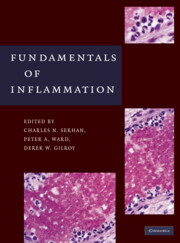Book contents
- Frontmatter
- Contents
- Contributors
- Preface
- PART I THE INFLAMMATORY RESPONSE – AN OVERVIEW
- PART II INDIVIDUAL CELL TYPES
- 4A Neutrophils I
- 4B Neutrophils II
- 5 Mast Cells as Sentinels of Inflammation
- 6 Basophils
- 7 Eosinophils
- 8 Macrophages
- 9 Lymphocytes
- 10 Fibroblasts and Stromal Cells
- 11 Neutrophil–Endothelial Cell Interactions
- PART III CHEMICAL MEDIATORS
- PART IV IMMUNOPHARMACOLOGY
- PART V INFLAMMATORY DISEASES/HISTOLOGY
- PART VI ANIMAL MODELS OF INFLAMMATION
- Index
- References
7 - Eosinophils
from PART II - INDIVIDUAL CELL TYPES
Published online by Cambridge University Press: 05 April 2014
- Frontmatter
- Contents
- Contributors
- Preface
- PART I THE INFLAMMATORY RESPONSE – AN OVERVIEW
- PART II INDIVIDUAL CELL TYPES
- 4A Neutrophils I
- 4B Neutrophils II
- 5 Mast Cells as Sentinels of Inflammation
- 6 Basophils
- 7 Eosinophils
- 8 Macrophages
- 9 Lymphocytes
- 10 Fibroblasts and Stromal Cells
- 11 Neutrophil–Endothelial Cell Interactions
- PART III CHEMICAL MEDIATORS
- PART IV IMMUNOPHARMACOLOGY
- PART V INFLAMMATORY DISEASES/HISTOLOGY
- PART VI ANIMAL MODELS OF INFLAMMATION
- Index
- References
Summary
INTRODUCTION
Eosinophilic granulocytes, commonly referred to as eosinophils, or less commonly as acidophils, were first identified by Paul Ehrlich in 1879. He named these bilobed nucleated cells as eosinophils because of their intense staining with the acidic dye eosin. Ehrlich completed his original studies that defined the eosinophil's morphological features during a time when he was committed to a clinical practice as well as basic research, an early example of a physician scientist. Combining his clinical expertise with his laboratory discoveries, he proposed a variety of functions for eosinophils that included phagocytosis, granule secretion, and chemotaxis.
Eosinophils are normally present as a minority of the peripheral blood leukocyte pool and primarily reside within tissues containing mucosal surfaces such as the uterus and gastrointestinal tract. While their exact function is not certain, eosinophils are thought to possess both beneficial and deleterious properties as participants in both innate and adaptive host immune responses. As an arm of the innate defense system, eosinophils are strongly proposed to be responsible in part for combating parasitic infections, particularly with helminths. When recruited in excess, eosinophils are currently thought to participate in mediating the pathogenesis of allergic diseases such as asthma, atopic dermatitis, gastrointestinal diseases, and hypereosinophilic syndromes.
EOSINOPHIL MORPHOLOGY
Eosinophils are approximately 12–17 μm in diameter, and represent 1%–6% of the total blood leukocyte population (Figure 7.1).
- Type
- Chapter
- Information
- Fundamentals of Inflammation , pp. 86 - 95Publisher: Cambridge University PressPrint publication year: 2010

